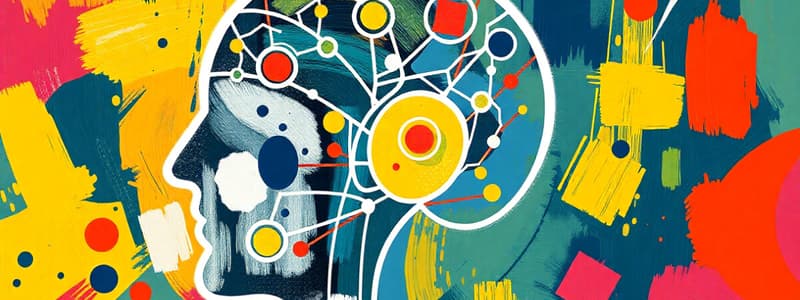Podcast
Questions and Answers
What was the primary way customers interacted with their neighborhood stores before the rise of supermarkets?
What was the primary way customers interacted with their neighborhood stores before the rise of supermarkets?
- Store owners recognized customers by name. (correct)
- Customers frequently switched stores.
- Transactions were mostly cash-based.
- They purchased goods anonymously.
What is the main reason organizations use CRM today?
What is the main reason organizations use CRM today?
- To increase the number of store locations.
- To replicate personal customer interactions. (correct)
- To reduce operational costs.
- To simplify the purchasing process.
What proportion of customers is said to generate the majority of profits?
What proportion of customers is said to generate the majority of profits?
- 10%
- 20% (correct)
- 75%
- 50%
How does the cost of acquiring new customers compare to obtaining repeat business?
How does the cost of acquiring new customers compare to obtaining repeat business?
What is a possible consequence of a typical dissatisfied customer?
What is a possible consequence of a typical dissatisfied customer?
What is a customer touch point?
What is a customer touch point?
What does a 360-degree view in CRM entail?
What does a 360-degree view in CRM entail?
Which phase in CRM evolution asks 'why it happened'?
Which phase in CRM evolution asks 'why it happened'?
In the context of CRM, what does the predicting phase focus on?
In the context of CRM, what does the predicting phase focus on?
Which type of interaction is NOT considered a traditional customer touch point?
Which type of interaction is NOT considered a traditional customer touch point?
How does AI enhance customer satisfaction in CRM?
How does AI enhance customer satisfaction in CRM?
What effect do AI-powered chatbots have on customer support?
What effect do AI-powered chatbots have on customer support?
What role does AI play in personalized marketing efforts?
What role does AI play in personalized marketing efforts?
In lead scoring, how does AI improve sales strategies?
In lead scoring, how does AI improve sales strategies?
How does AI contribute to automating routine tasks in CRM?
How does AI contribute to automating routine tasks in CRM?
What is the primary aim of a customer-focused organization?
What is the primary aim of a customer-focused organization?
Which aspect of customer relationship management involves personalized marketing?
Which aspect of customer relationship management involves personalized marketing?
How does CRM help in managing customer relationships?
How does CRM help in managing customer relationships?
In the context of CRM, what is meant by 'customer intimacy'?
In the context of CRM, what is meant by 'customer intimacy'?
What describes a collaborative CRM?
What describes a collaborative CRM?
One aspect of a customer-focused organization emphasizes customer differentiation. What does this entail?
One aspect of a customer-focused organization emphasizes customer differentiation. What does this entail?
Which of the following is NOT an aim of customer relationship management?
Which of the following is NOT an aim of customer relationship management?
What is a component of CRM used specifically to assist sales representatives?
What is a component of CRM used specifically to assist sales representatives?
What is the primary function of a sales lead tracking system?
What is the primary function of a sales lead tracking system?
Which strategy involves promoting additional related products based on previous customer purchases?
Which strategy involves promoting additional related products based on previous customer purchases?
What does a product knowledge system provide?
What does a product knowledge system provide?
What is one primary function of an Operational CRM system?
What is one primary function of an Operational CRM system?
What is the main feature of configurators in sales applications?
What is the main feature of configurators in sales applications?
Which of the following benefits does an Operational CRM provide?
Which of the following benefits does an Operational CRM provide?
What type of systems are considered customer-facing in an Operational CRM?
What type of systems are considered customer-facing in an Operational CRM?
Which of the following best defines upselling?
Which of the following best defines upselling?
Which channel is NOT typically used in Customer Interaction Centres (CIC)?
Which channel is NOT typically used in Customer Interaction Centres (CIC)?
What are customer-touching applications primarily designed to do?
What are customer-touching applications primarily designed to do?
Which of the following is a feature of Customer-Touching CRM systems?
Which of the following is a feature of Customer-Touching CRM systems?
What is the role of a sales forecasting system in a business?
What is the role of a sales forecasting system in a business?
Which of the following best describes bundling in a sales context?
Which of the following best describes bundling in a sales context?
In what type of CRM would you find Sales Force Automation (SFA) applications?
In what type of CRM would you find Sales Force Automation (SFA) applications?
What is the main goal of automating customer service and support in an Operational CRM?
What is the main goal of automating customer service and support in an Operational CRM?
How do outbound telesales fit into the Customer Interaction Centre model?
How do outbound telesales fit into the Customer Interaction Centre model?
Flashcards
Customer Touch Points
Customer Touch Points
Different ways a company interacts with customers, including traditional methods like phone calls and in-person interactions, and digital methods like email and website use.
Customer Relationship Management (CRM)
Customer Relationship Management (CRM)
A system for collecting and managing customer data to better understand their needs and increase customer loyalty and profits.
Data Consolidation
Data Consolidation
All customer information should be available to everyone who interacts with them.
CRM Reporting
CRM Reporting
Signup and view all the flashcards
Customer Loyalty
Customer Loyalty
Signup and view all the flashcards
Customer Data
Customer Data
Signup and view all the flashcards
CRM Analysis
CRM Analysis
Signup and view all the flashcards
Customer Profiling
Customer Profiling
Signup and view all the flashcards
CRM Predicting
CRM Predicting
Signup and view all the flashcards
Customer Acquisition Cost
Customer Acquisition Cost
Signup and view all the flashcards
Customer-focused organization
Customer-focused organization
Signup and view all the flashcards
Customer Identification
Customer Identification
Signup and view all the flashcards
Customer Differentiation
Customer Differentiation
Signup and view all the flashcards
Customer Interaction
Customer Interaction
Signup and view all the flashcards
Customization
Customization
Signup and view all the flashcards
CRM
CRM
Signup and view all the flashcards
Collaborative CRM
Collaborative CRM
Signup and view all the flashcards
CRM usage in sales
CRM usage in sales
Signup and view all the flashcards
Operational CRM System
Operational CRM System
Signup and view all the flashcards
Operational CRM Benefits
Operational CRM Benefits
Signup and view all the flashcards
Customer-Facing CRM systems
Customer-Facing CRM systems
Signup and view all the flashcards
Customer-touching CRM systems
Customer-touching CRM systems
Signup and view all the flashcards
Customer Service and Support
Customer Service and Support
Signup and view all the flashcards
Call center
Call center
Signup and view all the flashcards
Sales Force Automation (SFA)
Sales Force Automation (SFA)
Signup and view all the flashcards
Outbound Telesales
Outbound Telesales
Signup and view all the flashcards
AI-powered CRM
AI-powered CRM
Signup and view all the flashcards
Personalized Marketing
Personalized Marketing
Signup and view all the flashcards
Lead Scoring
Lead Scoring
Signup and view all the flashcards
Sentiment Analysis
Sentiment Analysis
Signup and view all the flashcards
Automate Routine Tasks
Automate Routine Tasks
Signup and view all the flashcards
Inbound Teleservice
Inbound Teleservice
Signup and view all the flashcards
Contact Management System
Contact Management System
Signup and view all the flashcards
Sales Lead Tracking System
Sales Lead Tracking System
Signup and view all the flashcards
Product Knowledge System
Product Knowledge System
Signup and view all the flashcards
Cross-selling
Cross-selling
Signup and view all the flashcards
Upselling
Upselling
Signup and view all the flashcards
Bundling
Bundling
Signup and view all the flashcards
e-CRM (Electronic Customer Relationship Management)
e-CRM (Electronic Customer Relationship Management)
Signup and view all the flashcards
Study Notes
Management Information Systems (MIS) Lecture Notes
- Course code: ADM 2372
- Instructor: Mayur Joshi, PhD
- Contact email: [email protected]
- Copyright information provided
- All rights reserved, no reproduction, storage, or transmission without instructor permission
Week 8: Customer Relationship Management (CRM)
- Chapter 11
- Agenda:
- Why CRM?
- Defining CRM
- Operational CRM
- Analytical CRM
- Examples
- Role of AI in CRM
ERP: New Generation
- Current ERP systems (ERP II) offer web-enabled access for customers, suppliers, and partners via connections (e.g., VPN).
ERP: Core and Extended Modules
- ERP systems have core modules (accounting & finance, manufacturing & production, human resources, supply chain management) and integrated extended modules (business intelligence, e-business, customer relationship management) connected to the ERP platform and database.
ERP: Modules and Other Systems
- Shows integration of ERP (accounting, finance, human resources, marketing, sales, operations, and production management) with CRM, SCM, and organizational levels of business (executive, management, transaction). —Also shows business to consumer (B2C) and business to business (B2B) e-commerce transactions.
The Customer is King!
- Historical context: Neighborhood stores prioritized knowing customers' needs and fostering loyalty.
- Modern approach: CRM aims to replicate this through data collection and analysis.
- Examples from Amazon: Vision is customer-focused.
How? Why?
- Customer profiles & personalization
- Low customer acquisition vs. customer retention costs; acquisition is 5-10 times more expensive than retention.
- Dissatisfied customers disproportionately impact others.
Defining CRM
- CRM is a customer-centric organizational strategy, not just software.
- Enables personalized marketing and intimate business relationships with customers. -Supports customer acquisition, retention, and relationship growth.
Collaborative CRM
- Integrates marketing, sales, and service communications across the organization.
Defining CRM (cont.)
- RFM (Recency, Frequency, and Monetary value) used to identify valuable customers. This is a way to measure customer value from customer data.
CRM Process
- Organization solicits potential customers.
- Some customers become repeat customers.
- Organizations segment repeat customers into low-value and high-value groups.
- Customers sometimes churn over time.
- Goal is to maximize high-value repeat customers and minimize churn.
CRM: Strategy versus System
- CRM strategy is the customer-centric orientation of the organization.
- CRM systems support the strategy through information systems.
Customer Touch Points
- Different ways organizations interact with customers.
- Includes traditional methods (e.g., phone calls, direct mail).
- Includes digital methods (e.g., email, website interactions, mobile apps).
Data Consolidation
- All customer data needs to be accessible across all departments and employees interacting with customers.
- CRM for a 360-degree view of every customer interaction.
CRM Evolution
- Stages of CRM: Reporting, Analysis, and Prediction.
Operational CRM System
- Supports daily front-office operations.
- Deals directly with customers.
- Automates tasks like call centers, marketing campaigns, and sales processes
Operational CRM Systems (Benefits)
- Efficient, personalized marketing/sales/service
- Comprehensive 360-degree customer view.
- Access to customer history data across all touch points.
Operational CRM (Types)
- Customer-facing: CRM used by employees directly interacting with customers.
- Customer-touching: Systems customers utilize for interactions (email, FAQ, loyalty programs, etc.)
Customer-Facing Applications
- Customer service & support.
- Sales Force Automation (SFA).
- Marketing
- Campaign Management.
Customer Service & Support
- Automation of requests, complaints, returns, and information.
- Customer Interaction Centers (CIC) with various channels (website, phone, fax).
- Call centers, outbound/inbound telesales, and other forms of customer support.
Sales Force Automation (SFA)
- Tracks sales transactions, contacts, and follow up.
- Provides sales leads and forecasting tools.
Marketing
- Enables identifying best customers & running marketing campaigns.
- Uses cross-selling/upselling strategies.
- Enables grouping/bundling products for selling.
Customer-Touching Applications
- e-CRM: Customer self-help apps (search, comparison).
- Technical information and support (product manuals, replacement parts, FAQs).
- Customized products & services with options available.
Customer-Touching Applications (cont.)
- Personalized web pages for personalized customer experience.
- FAQs and chatbots for repetitive queries.
- Email and automated response feature.
- Loyalty programs.
Operational CRM: Example in Marketing
- Email marketing system from Oracle Siebel CRM: guides marketing campaigns (design, launch, tracking, evaluation).
- System shows email campaign creation, email template design, template contents, and customization.
- System for creating and launching email campaigns.
Operational CRM: Example in Sales
- Sales Force Automation (SFA) from SugarCRM: tracks sales steps.
- Displays functionalities, including customer management, opportunities, pipeline, and sales forecasting views.
Operational CRM: Example in Sales (cont.)
- Contact management system to identify prospective customers for future sales.
- Shows examples of storing/accessing contact data, managing, and generating new customer opportunities.
Operational CRM: Example in Sales (cont.)
- Opportunity Management system from SugarCRM to find/target future sales opportunities; shows relevant dashboards, opportunity lists, and details.
Operational CRM: Example in Customer Service
- Call center system: Supports customer inquiries & issues resolutions by CSRs.
- System screens displays elements like customer service requests, resolution steps, and customer information for CSRs.
Analytical CRM
- BI tools providing business intelligence for analyzing customer data.
- Finding new customers similar to existing best customers (e.g., based on demographics, location, purchasing behavior).
- Reactivation of inactive customers with customized communications, offers, and discounts..
Analytical CRM: Example in Marketing
- Marketing analysis from SugarCRM: Measures ROI, tracking campaign results, and understanding campaign effectiveness.
- Shows examples of campaign analytics and ROI dashboards.
- Provides visuals of campaign and customer data to determine its effect on business.
Analytical CRM: Example in Sales
- Sales analytics from Siebel CRM (now part of Oracle).
- Customizable dashboards and key performance indicators (KPIs) to boost sales efficiency.
- Provides sales pipeline insights from various views (pipeline overview, lead quality, deal size, top opportunities)
Operational vs Analytical CRM
- Operational CRM handles interactions with customers in marketing, sales, and service. Analytical CRM analyzes customer data (e.g., using data warehousing or data marts) with BI tools and insights to plan ahead.
Examples of new CRM products
- Microsoft Dynamics CRM for sales, marketing, and service.
CRM & Privacy
- Customer concerns about data collection within CRM systems.
- Demonstrating that some customers value these systems.
CRM Metrics
- Measures of effectiveness for CRM systems in various areas (e.g. sales cycle, revenue per customer, average order size, customer acquisition and retention costs, campaign response, marketing & service efficiency).
What you can do with CRM
- Salesforce website for accessing and starting a free CRM trial.
Role of AI in CRM
- Customer insights and predictions: AI analyzes customer data to improve customer relationships through personalized experiences based on insights.
- Automated Customer Support: AI-powered chatbots enable 24/7 customer support via instant responses, freeing up human agents to handle complex cases and issues.
- Personalized Marketing and Sales: AI segments audiences, tailors marketing efforts, and increases customer satisfaction rates with more relevant product/service offerings.
- Lead Scoring and Forecasting: AI anticipates conversion likelihoods for improving sales team efficiency in targeting the most promising leads.
- Automating Routine Tasks: AI automates repetitive tasks (data entry, updating customer information, scheduling follow-ups), boosting CRM efficiency and minimizing human error.
- Sentiment Analysis: Analyzing customer feedback for proactively addressing concerns and enhancing customer experience.
Studying That Suits You
Use AI to generate personalized quizzes and flashcards to suit your learning preferences.




